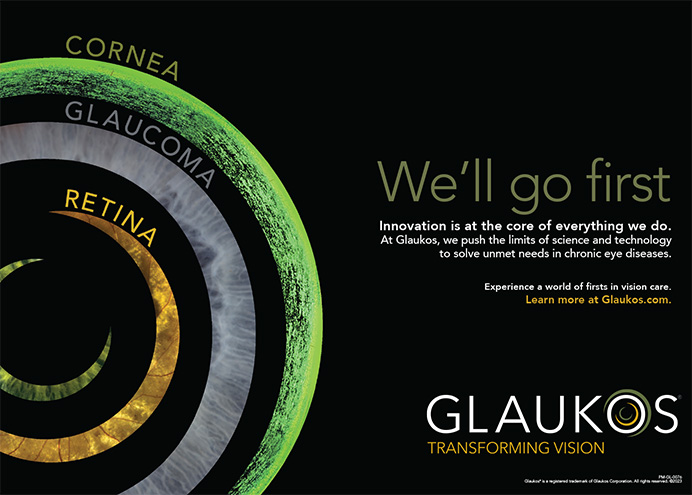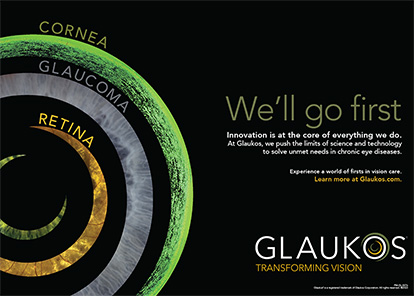
TOPICAL NONSTEROIDAL ANTI-INFLAMMATORY DRUGS AND CATARACT SURGERY: A REPORT BY THE AMERICAN ACADEMY OF OPHTHALMOLOGY
Kim SJ, Schoenberger SD, Thorne JE, et al1
Abstract Summary
Kim and colleagues performed a large-scale meta-analysis of the current evidence on the effectiveness of prophylactic nonsteroidal anti-inflammatory drugs (NSAIDs) alone and in conjunction with corticosteroids for preventing vision loss resulting from cystoid macular edema (CME) after cataract surgery.
AT A GLANCE
• A large meta-analysis found no evidence that NSAIDs prevent vision loss from CME at 3 months and beyond after surgery, that NSAIDS are synergistic with steroids, or that NSAIDs exhibit greater efficacy at controlling inflammation compared with steroids.
• Another large meta-analysis determined that the use of topical NSAIDs reduced the odds of developing CME in both nondiabetic and diabetic patients and that a combination of corticosteroids and NSAIDs was more effective than steroids alone at decreasing the incidence of CME in these populations.
• A study of newer-generation NSAIDs showed that steroids alone are inferior to NSAIDs in terms of maintaining mydriasis during cataract surgery, reducing postoperative inflammation, and resisting macular thickening in both diabetic and nondiabetic patients.
Of the 149 articles the researchers reviewed from the Cochrane Library database, they rated 15 as level 1 or 2 evidence. All 15 studies were published between 1980 and 2012. Six of the nine level 1 studies were published before 2000. The majority (66%) of the NSAIDs evaluated in these studies were indomethacin and ketorolac. One study each evaluated flurbiprofen and diclofenac. Nepafenac was part of two of the level 1 studies. None of the studies evaluated included bromfenac.
The authors concluded that topical NSAIDs were effective in reducing CME, as evidenced on both angiography and optical coherence tomography (OCT), and in enhancing the speed of visual rehabilitation after surgery by approximately 2 weeks compared with both placebo and corticosteroids with limited penetration. The investigators did note, however, that outcomes at 3 months postoperatively, both with and without topical NSAIDs, tended to be similar, which they attributed to the fact that postoperative CME is often mild and can resolve spontaneously.
The researchers concluded that there was no evidence to support the assertion that NSAIDs prevented vision loss from CME at 3 months and beyond after surgery. They also found no support for the assertion that NSAIDs are synergistic with steroids or that the former demonstrate improved efficacy at controlling inflammation compared with steroids. Finally, they reported that the lack of standardized testing and reporting of CME in the literature prevented accurate assessments of both the incidence of CME and its response to therapies.
DISCUSSION
This large-scale meta-analysis challenges most of what is generally believed to be true and is even considered the standard of care regarding the prevention of inflammation and CME after cataract surgery.
Since CME was first described over 50 years ago, the condition has become known as one of the most common causes of vision loss after cataract surgery.2 Its prevalence is largely unknown, but the complication is estimated to occur in 4% to 23% of healthy eyes and in up to 56% of eyes with nonproliferative diabetes, many of which do not lose visual acuity.3,4 The prevalence of clinically significant CME has been estimated to be lower, between 0% and 5.8%.5
In recent years, OCT technology has spotlighted the prevalence of macular thickening and postoperative CME, revealing that up to 70% of all patients may experience some macular thickening postoperatively.6,7 Macular thickening has been shown to lead to a loss of contrast sensitivity, even if visual acuity remains the same.8
Kim et al also evaluated the cost-benefit ratio of topical NSAIDs for routine cataract surgery to society and to patients. The investigators speculated that the societal cost of routinely using brand-name NSAIDs in cataract surgery for 3 million patients annually approached $500 to $700 million.1 The researchers did not evaluate or include other potential additional costs of short- or long-term CME such as additional office visits, lost wages, additional topical medications, injections required for treatment, or potential legal costs.
This study does not include a significant or substantial analysis of newer-generation NSAIDs, which have been suggested to be more efficacious than older-generation NSAIDs.9 Faster visual rehabilitation and consistent, improved visual outcomes must be balanced with potential costs to both patients and society.
PREVENTION OF CYSTOID MACULAR EDEMA AFTER CATARACT SURGERY IN NONDIABETIC AND DIABETIC PATIENTS: A SYSTEMATIC REVIEW AND META-ANALYSIS
Wielders LH, Lambermont VA, Schouten JS, et al10
Wielders and colleagues conducted a large-scale meta-analysis that reviewed the Cochrane, Medline, and Embase databases for eligible randomized controlled trials to evaluate the optimal medical strategy to prevent CME within 3 months after uncomplicated cataract surgery in diabetic and nondiabetic patient populations. The investigators evaluated foveal thickness, macular volume, and the change in BCVA within 3 months postoperatively compared with baseline in studies that met criteria using the Cochrane Collaboration’s tool for assessing risk of bias and Delphi criteria. Seventeen studies were evaluated. Wielders et al concluded that topical NSAIDs significantly reduced the odds of developing CME compared with topical corticosteroids, both in nondiabetic (odds ratio [OR], 0.11; 95% CI, 0.03-0.37) and mixed populations (OR, 0.05; 95% CI, 0.02-0.11). The investigators remarked that the combination of topical corticosteroids and NSAIDs significantly reduced the odds of developing CME compared with topical corticosteroids alone, both in nondiabetic (OR, 0.21; 95% CI, 0.10-0.44) and diabetic patients (OR, 0.17; 95% CI, 0.05-0.50). Intravitreal corticosteroids or antivascular endothelial growth factor injections evaluated separately did not show additional benefit in diabetic subjects. This European meta-analysis was undertaken in part to elucidate the best strategy to prevent CME in both nondiabetic and diabetic patients. Its findings are the impetus for the Prevention of Macular Edema after cataract surgery (PREMED) study, in which investigators at 18 European centers are evaluating the change in central subfield mean macular thickness on OCT 6 weeks postoperatively.11 Wielders and colleagues showed that the use of topical NSAIDs reduced the odds of developing CME in nondiabetic and diabetic patients alike and that a combination of corticosteroids with NSAIDs was more effective than steroids alone at decreasing the incidence of CME in these patients. Jung JW, Chung BC, Kim EK, et al12 Jung et al compared the additive effects of bromfenac 0.1% and ketorolac 0.45%, relative to a topical steroid alone in cataract surgery. Ninety-one subjects were enrolled in a prospective trial and randomized to receive pre- and postoperative bromfenac 0.1% alone, pre- and postoperative preservative-free ketorolac 0.45% alone, or steroid alone. Outcome measures included intraoperative miosis, postoperative anterior chamber inflammation, postoperative macular thickness and volume, and ocular surface status after surgery. According to the researchers, both NSAID groups had smaller intraoperative changes in pupillary diameter during surgery compared with the control group. Both NSAID groups had significantly less ocular inflammation at 1 week and 1 month postoperatively compared with the steroid-alone group. The change in central foveal subfield thickness from baseline to 1 month was 4.3 ±4.25, 4.87 ±6.03, and 12.47 ±12.24 in the bromfenac, ketorolac, and steroid groups, respectively. Macular thickness and volume increased significantly in patients with diabetes mellitus using steroids compared to those without diabetes using steroids. In contrast, significantly reduced macular changes were noted in patients with and without diabetes from both NSAID groups. The authors concluded that pre- and postoperative NSAIDs reduced intraoperative miosis, improved postoperative inflammation, and controlled macular volume changes more effectively than steroids alone. This study looked at the results of newer-generation NSAIDs used postoperatively compared with corticosteroids. Based on Jung and colleagues’ findings, steroids alone are inferior to NSAIDs in terms of maintaining mydriasis during cataract surgery, reducing postoperative inflammation, and resisting macular thickening in both diabetic and nondiabetic patients. NSAIDs have become the standard of care for controlling postoperative inflammation after cataract surgery, although their role in preventing CME has been controversial. Significant differences exist between newer-generation NSAIDs and older ones, including specificity for cyclooxygenase-1 and cyclooxygenase-2 enzymes, the degree of penetration into the eye, tolerability, safety, and dosing convenience. Any analysis including older, less effective NSAIDs may, therefore, be naturally skewed toward unfavorable results. Two of the three studies summarized in this article proved that the addition of any NSAID to the postoperative routine was effective at reducing CME and enhancing the speed of visual recovery. A more complete financial analysis of the impact of omitting them must include the cost of lost efficiencies for physicians in the office and in surgery, the cost of surgical complications due to miosis, additional office visits, testing, and interventions for CME as well as lost work time for patients and potential legal costs. It is possible that cataract surgeons and retinal physicians could ultimately have differing opinions on the acceptable percentage of patients experiencing temporary or permanent CME following cataract surgery. 1. Kim SJ, Schoenberger SD, Thorne JE, et al. Topical nonsteroidal anti-inflammatory drugs and cataract surgery: a report by the American Academy of Ophthalmology. Ophthalmology. 2015;122(11):2159-2168. 2. Cable M. Comparison of bromfenac 0.09% QD to nepafenac 0.1% TID after cataract surgery: pilot evaluation of visual acuity, macular volume and retinal thickness at a single site. Clin Ophthal. 2012;6:997-1004. 3. Yonekawa Y, Kim IK. Pseudophakic cystoid macular edema. Curr Opin Ophthalmol. 2012;23(1):26-32. 4. Diabetic Retinopathy Clinical Research Authors/Writing Committee. Macular edema after cataract surgery in eyes without preoperative central-involved diabetic macular edema. JAMA Ophthalmol. 2013:131(7):870-879. 5. Packer M, Lowe J, Fine H. Incidence of acute postoperative cystoid macular edema in clinical practice. J Cataract Refract Surg. 2012:38(12):2108-2111. 6. Eriksson U, Alm A, Bjarnhall G, et al. Macular edema and visual outcomes following cataract surgery in patients with diabetic retinopathy and controls. Graefes Arch Clin Exp Ophthalmol. 2011:249(3):349-359. 7. Perente I, Utine CA, Ozturker C, et al. Evaluation of macular changes after uncomplicated phacoemulsification surgery by optical coherence tomography. Curr Eye Res. 2007:32(3):241-247. 8. Wittpenn JR, Silverstein S, Heier, et al. A randomized, masked comparison of topical ketorolac 0.4% plus steroid vs steroid alone in low-risk cataract surgery patients. Am J Ophthalmol. 2008;146(4):554-560. 9. Tzelikis PF, Vieira M, Hida WT, et al. Comparison of ketorolac 0.4% and nepafenac 0.1% for the prevention of cystoid macular oedema after phacoemulsification: prospective placebo-controlled randomized study. Br J Ophthalmol. 2015;99(5):654-658. 10. Wielders LH, Lambermont VA, Schouten JS, et al. Prevention of cystoid macular edema after cataract surgery in nondiabetic and diabetic patients: a systematic review and meta-analysis. Am J Ophthalmol. 2015;160(5):968-981. 11. Nuijts RM, Simons RW, Wielders LH, et al. Prophylactic treatments against CME after cataract surgery. Cataract & Refractive Surgery Today Europe. 2015;10(5):51-53. bit.ly/1OURUyE. 12. Jung JW, Chung BH, Kim EK et al. The effects of two non-steroidal anti-inflammatory drugs, bromfenac 0.1% and ketorolac 0.45% on cataract surgery. Yonsei Med J. 2015;56(6):1671-1677. Section Editor Edward Manche, MD Melissa Toyos, MDABSTRACT SUMMARY
DISCUSSION
THE EFFECTS OF TWO NONSTEROIDAL ANTI-INFLAMMATORY DRUGS, BROMFENAC 0.1% and KETOROLAC 0.45% ON CATARACT SURGERY
ABSTRACT SUMMARY
DISCUSSION
• director of cornea and refractive surgery at the Stanford Eye Laser Center
• professor of ophthalmology at the Stanford University School of Medicine, Stanford, California
• edward.manche@stanford.edu
• partner, Toyos Clinic Nashville, Tennessee
• (615.327-4015)mtoyos@toyosclinic.com


